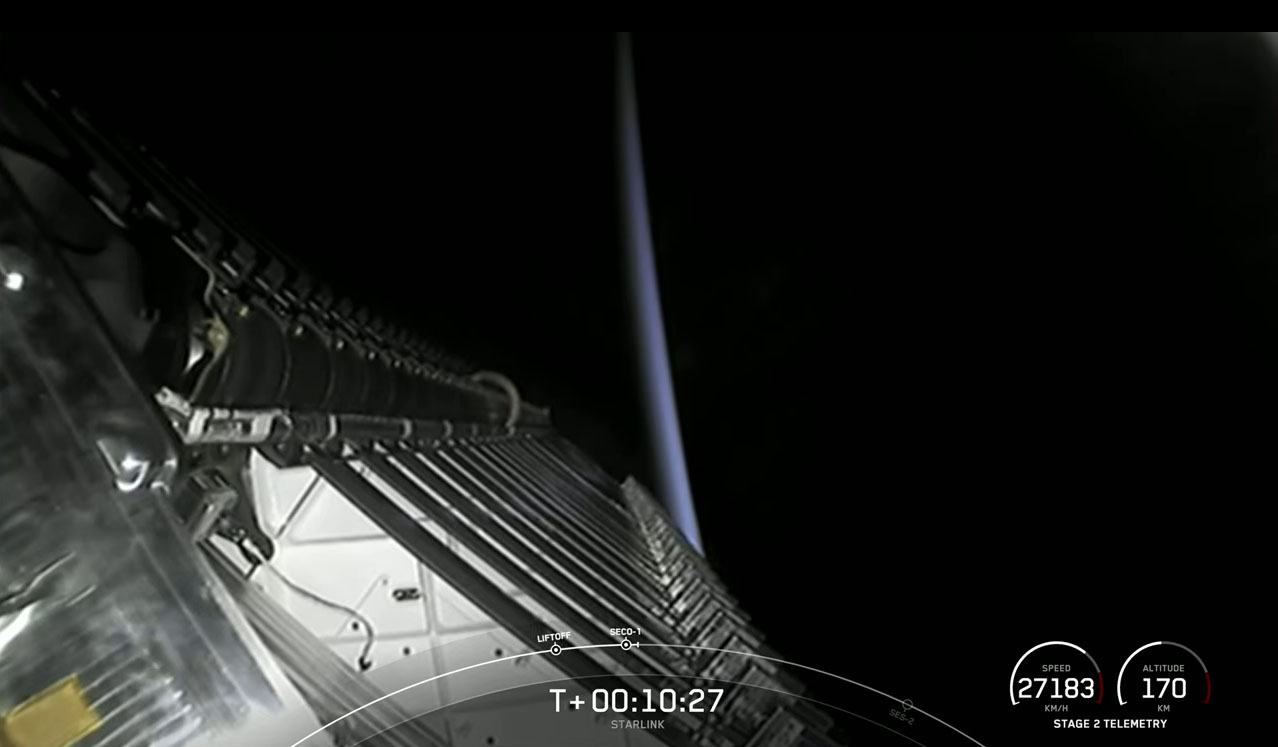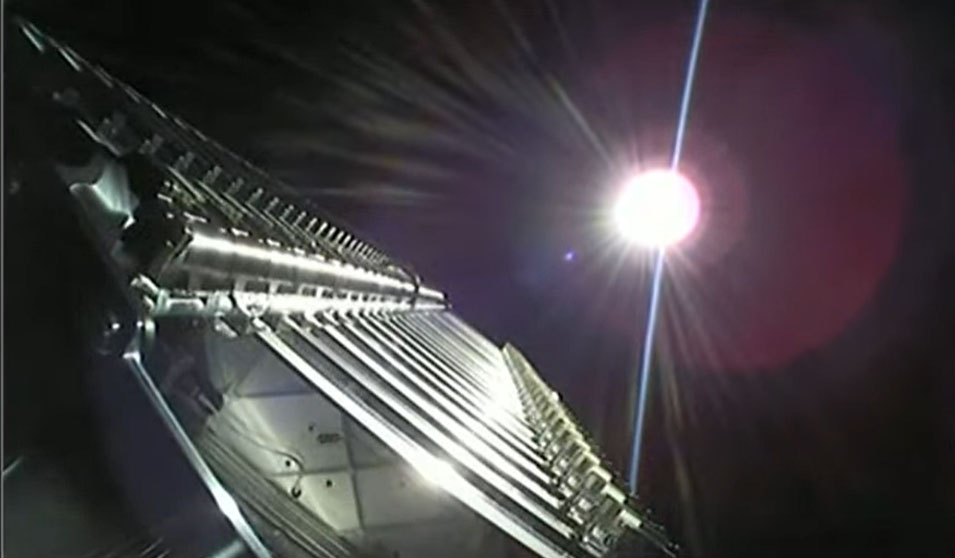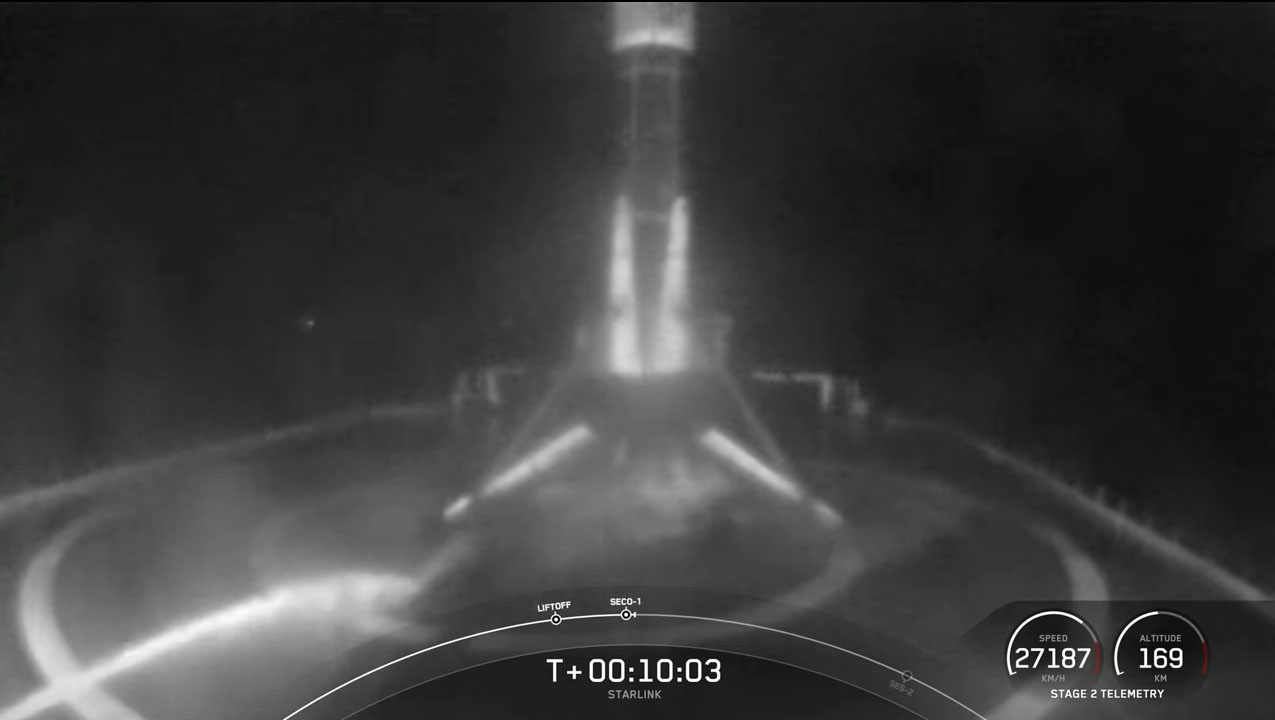SpaceX launches 60 Starlink satellites in record 10th liftoff (and landing) of reused rocket
SpaceX's reusable rockets have now hit double digits.
CAPE CANAVERAL, Fla. — A SpaceX Falcon 9 rocket launched 60 Starlink internet satellites into orbit early Sunday (May 9) and then stuck a landing at sea to cap a record 10th flight for the company's reusable booster.
The veteran Falcon 9 rocket blasted off before dawn from Space Launch Complex 40 here at Cape Canaveral Space Force Station at 2:42 a.m. EDT (0642 GMT), marking the company's 14th launch of the year. It was also one for the record books as the flight was this particular booster's 10th launch and landing attempt. The rocket's once pristine exterior was almost black, charred by its many trips to orbit and back.
"First time a Falcon rocket booster will reach double digits in flights," SpaceX CEO Elon Musk wrote on Twitter Saturday before launch.
Related: SpaceX's Starlink satellite megaconstellation launches in photos





Join the Space.com forums here to discuss SpaceX and space travel. Let the community know what you're thinking!
The successful liftoff marked the second time SpaceX launched one of its 229-foot-tall (70 meters) workhorse Falcon 9 rockets within the same week, each carrying a full stack of 60 flat-paneled Starlink broadband satellites.
"SpaceX's first reuse of an orbital class rocket was on the SES-10 mission way back in March of 2017," Spacex supply chain supervisor Michael Andrews said in a live webcast. "We've certainly come a long way since then."
Approximately nine minutes after liftoff, the rocket's first stage returned to Earth, touching down on SpaceX's drone ship "Just Read the Instructions" for a record 10th successful landing.
Breaking space news, the latest updates on rocket launches, skywatching events and more!
Onlookers were treated to quite the spectacle as the rocket lit up the pre-dawn sky as it climbed to orbit. Clear skies above Florida's Space Coast made for prime viewing conditions.
In photos: SpaceX launches, lands 1st reused Falcon 9 rocket
In 2020, SpaceX launched a record 26 rockets, and the company is showing no signs of slowing down. So far this year, the Hawthorne, California-based rocket builder has launched 14 missions. Every one of those launches has been on reused rockets, and most have carried SpaceX's own Starlink satellites.
Last month, SpaceX celebrated the launch of its third astronaut mission in less than a year as the private spaceflight company delivered a crew of four astronauts to the International Space Station. That mission, called Crew-2, was SpaceX's first crewed mission to fly on a reused rocket.
Of its 14 missions this year, 11 have carried Starlink satellites into orbit. SpaceX has already filled its initial internet constellation of 1,440 broadband satellites. However, the company has approval to launch thousands more and is relying on its fleet of flight-proven boosters to help it do so.
SpaceX's 1st 'Block 5' Falcon 9 rocket: The launch photos
Reusable rocket milestone
The booster used in Sunday's launch, called B1051, is one of SpaceX's fleet leaders. The veteran flier now has 10 launches and landings under its belt as the company has plans to push its Falcon 9 rockets to the limit. It's the first booster in SpaceX's fleet to reach this milestone. (Another booster, B1049, just launched on its ninth mission earlier in the week.)
This Falcon 9 made its debut in 2019, launching an uncrewed Crew Dragon capsule on the Demo-1 mission as part of a test flight for NASA's Commercial Crew program. The booster also launched a trio of Earth-observing satellites for Canada, a broadband satellite for Sirius-XM and seven different Starlink missions.
SpaceX has been using its previously flown boosters with the most miles to transport its own satellites into space. That way the company can push its fleet of Falcons to the limit while also learning as much about the wear and tear each vehicle receives during launch.
This is the 118th overall flight for Falcon 9, and the 64th flight of a refurbished booster. In fact, every single SpaceX launch so far in 2021 has been on a flight-proven rocket.
In 2018, SpaceX debuted the rocket we see today, a version of Falcon 9 known as Block 5. This more capable Falcon 9 has ushered in an era of rapid reusability for the company, enabling SpaceX to launch more rockets than ever before.
Three years ago, SpaceX CEO and founder Elon Musk told reporters that the company expected each Falcon 9 to fly 10 times with few refurbishments in between flights, and as many as 100 times before retirement.
B1051 is the first to make it to the historic 10-flight milestone, and is expected to fly again, following its successful landing at sea. According to Musk, there doesn't appear to be a hard limit on the number of times a booster can be reused, so the company will continue pushing each Falcon to its limit.
Having a fleet of flight-proven rockets at its disposal allows SpaceX to keep up with its rapid launch cadence. However, SpaceX chooses to fly its own payload on boosters with a high flight count, saving its newer boosters for paying customers.
Both NASA and the U.S. Space Force recently granted the company approval to fly their payloads on reused rockets, and we saw the first of those missions blast off on April 23, with the launch of Crew-2. (SpaceX has flown other NASA missions on reused boosters, but April's flight marked the first time a human mission has done so.)
To facilitate reuse, SpaceX outfitted its Falcon 9 with some upgrades previous versions did not have, including a more robust thermal protections system, a more durable interstage (the part that connects the rocket's first stage to the upper stage), titanium grid fins, and more powerful engines. These key enhancements, along with two drone ships on the same coast, have enabled SpaceX to launch and land more rockets.
Starlink constellation grows
SpaceX created its massive internet constellation with one major goal: to provide internet coverage to the world, in particular to those in remote and rural areas. To that end, company engineers designed a fleet of flat-paneled broadband satellites to fly over the Earth, beaming down internet coverage to users who can access the service via a compact user terminal.
With Sunday's launch success, SpaceX has launched more than 1,600 Starlink satellites into orbit, including some that are no longer operational. This goes beyond the company's initial quota, which means we should see an official commercial rollout of the Starlink internet service sometime this year.
The company has already proven useful to those in remote areas. SpaceX has connected school districts in Virginia and North Carolina that would otherwise struggle with online learning, as well as the Hoh tribe in Washington State and the Pikangikum nation in Western Ontario.
Starlink review (hands-on): How good is Elon Musk's satellite internet service?
Currently, Starlink is still in its beta-testing phase with users around the world putting the service through its paces. The company has also opened up its website to begin taking preorders, although service won't begin right away. Prospective users can go to the company's website and reserve the service with a $99 deposit right now.
According to company officials, more than 500,000 users have signed up for the burgeoning service so far.
Rocket fairing recovery
Both of the fairing halves featured in Tuesday's mission will be recovered by the newest member of SpaceX's recovery fleet, Shelia Bordelon. The company officially bid farewell to its dynamic duo — GO Ms. Tree and GO Ms. Chief — last month. The twin fairing catchers helped SpaceX pioneer its fairing recovery efforts.
The rocket's nose cone (also called a fairing), is a piece of clamshell-like hardware that protects the payload as the rocket races through the atmosphere. Once it reaches a certain altitude, the pieces jettison, and fall back to Earth.
Historically, the hardware was discarded in the ocean, never to be used again. However, thanks to onboard parachutes and navigation software, SpaceX began to recover the fairings, either by catching them in a net-equipped boat or scooping them out of the water.
With the help of its onboard crane, the brightly painted Shelia Bordelon will retrieve the fairings from the water and return them to port. From there, they will be refurbished and prepared for their next mission.
Follow Amy Thompson on Twitter @astrogingersnap. Follow us on Twitter @Spacedotcom or Facebook.

Amy Thompson is a Florida-based space and science journalist, who joined Space.com as a contributing writer in 2015. She's passionate about all things space and is a huge science and science-fiction geek. Star Wars is her favorite fandom, with that sassy little droid, R2D2 being her favorite. She studied science at the University of Florida, earning a degree in microbiology. Her work has also been published in Newsweek, VICE, Smithsonian, and many more. Now she chases rockets, writing about launches, commercial space, space station science, and everything in between.

